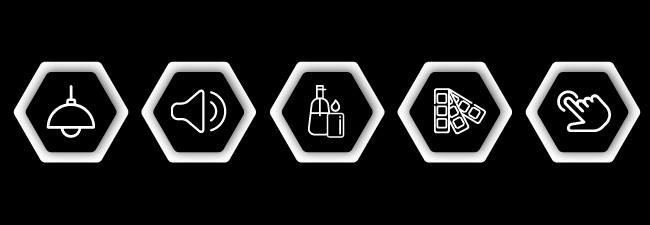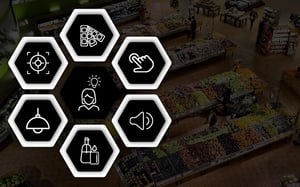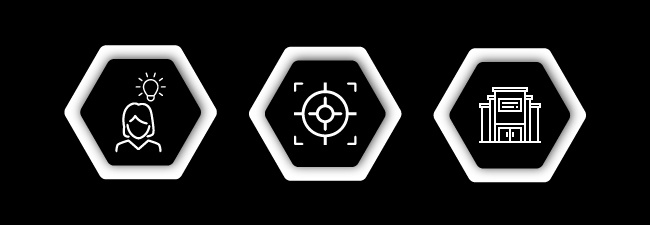When talk turns to how you can improve the shopping experience of your customers, you'll undoubtedly overhear discussions around customer service. Or, about which store policies to implement. And, over what products to stock to ensure shoppers return. That said, there is another matter worth considering that might not get as much airtime. That's your store atmospherics.
What is atmospherics (and why does it matter)?
As a retail term, ‘atmospherics’ is simple to unpack, so we’re not going to go into too much depth explaining it. It’s the ‘why does it matter’ that's the far more interesting question.
Here’s a brief explanation before we continue:
Atmospherics refers to the atmosphere or mood you create in your store by introducing various elements and effects. When done consistently, it allows you to build and develop your store personality - the identity that gives life to your retail brand. That means you can also use it to differentiate yourself from your competitors.
Of course, there is more to it. Marketing author and consultant, Philip Kotler, who was the first to coin the term - in a 1973 article in the Journal of Retailing - believes the atmosphere you create in your store to be just as, if not more important, than the products you decide to stock.
That’s because of one simple reason: An appealing in-store atmosphere has a positive impact on the overall behavior of your customers. It’s a key tactic you can use to influence shopper behavior. What’s more, it’s also linked to visual merchandising. And you’d only need to consider the different elements to understand the truth.
We’ll dig into each of the critical atmospheric components below. For now, it’s worth pointing out this: The difference between getting it right or wrong can mean a customer shopping for longer and increasing their basket size or walking out without buying anything.

How to make the most of atmospherics
While the specific atmospheric elements you chose for your store can vary significantly from your competitors, the fundamentals remain the same. That is because this is about creating a pleasant shopping environment that encourages customers to stay in your store for longer and, while there, spend more.
And the best way of accomplishing that is to appeal to the senses.
1. Lighting
The first significant element that plays a role in creating the right mood is the lighting you choose. That’s because while subtle, it goes a long way to encouraging or discouraging customers to walk into your store and shop.
For example, if you choose lighting that is too dark, you create a foreboding store mood. Unless that is your aim and it fits your retail brand, you’re subconsciously telling customers not to visit. Too light, however, and you could blind your customers and discourage them from returning.
So, how do you take advantage of your lighting?
Firstly, you need to consider your lighting options. There is general or ambient lighting, task lighting, accent lighting, and decorative lighting. Each will suit a different part of your store and fulfill a specific role.
From there, it’s a case of looking at the products you sell and matching them to the type of lighting that you believe will highlight them best. Also, ask yourself what you want your customers to feel when they see or interact with products in your store.
Do you want them to feel nostalgic? Then decorative lighting would be the way to go. Do you want them to believe that a product is important? Then accent lighting is a better bet.
Let’s say that you’re a consumer electronics retailer. In that case, you’d be better off choosing bright lighting to highlight your products. Meanwhile, if you sell groceries or have an in-store bakery, it would be better to pick warm, soft lighting since that encourages shoppers to browse your store for longer.
2. Music
Besides the lighting for your store, the music you choose also plays a role in creating the right mood for your store (and retail brand).
There are a few steps you can take to choose the right music. Most are a result of answering a set of questions.
Firstly, what type of mood do you want to create? Do you want a fun and happy shopping environment? Then it’s worth playing upbeat music. Are you more interested in creating a calm and relaxed atmosphere? Then it’s a better idea to invest in classical or jazz music with a low tempo.
On that, the tempo of your music plays a key role too. While slow music encourages your customers to browse your store, high-tempo music will see your customers moving through your store quickly. Of course, there are extremes to both. Too slow and you’ll bore (and even irritate) shoppers. Too fast and they’ll feel rushed.
Volume is another factor, albeit an obvious one. By turning the volume too high, subconsciously, you’re telling your customers to cut their shopping time. There is even research, which shows that music loudness impacts how long your customers spend time in your store. But, by lowering the volume too much, you could sabotage yourself, making the shopping experience awkward and uncomfortable.
Lastly, you need to consider the type of customer you want to attract. Are you looking to attract young or older customers? Are they male or female? Then you need to choose music to match what they expect while they shop.
Imagine you run a pharmacy, and you play deep bass. Or, you’re a clothing retailer explicitly aimed at the youth, and you play classical music. Both situations will work against you rather than for you.
If you’re unsure about what music to play and have the budget, it’s worth considering investing in an in-store radio station that caters to your target market.
3. Scent
While sight and sound are the two most prominent senses that all retailers should use, there is another sense that you would do well to consider. And that’s regardless of the type of retailer you are or the products you sell.
As the sub-heading points out, that’s the scent you’d utilize in your store. And yes, it can work for you no matter what type of products you sell.
That’s because you can use smell to enhance the shopping experience. The most obvious example is if you have an in-store bakery. With the smell of freshly baked bread or other baked goods, you can invite people in, and keep them there.
Another common tactic is to use floral scents. And there is a good reason why it’s so common. Floral scents are known to increase the time a shopper spends in a store.
Of course, you don’t have to use floral scents or baked goods and keep them near your entrance. Other specific scents also offer you positive responses.
For example, if you’re going for a relaxed mood in your store, it’s also worth including scents such as lavender, basil, cinnamon, or orange as they are known for reducing anxiety.
Meanwhile, if you want to give your customers a feeling of warmth and ensure they feel comfortable while browsing your store, vanilla is a scent.
Besides that, you could also look at introducing a specific scent during a particular season or around an event. For example, over Valentine’s Day, you could think about ginger, chocolate, or cardamom scent since this evokes feelings of romance and love.
4. Color
Psychologically speaking, people attribute certain emotions to colors. That is why it is such a powerful visual merchandising tool. Color can change the whole mood of your store and anyone who enters it.
For example, yellow evokes happiness and cheerfulness. It’s associated with summer and the beach and is upbeat. While red evokes passion and anger, it’s also warm and the color of love. Meanwhile, grey is a calming color, and while it can appear elegant and sophisticated, it could also dampen the mood if misused.
That said, as much as there has been in-depth exploration around color and its psychological influence on shoppers, that doesn’t mean it’s foolproof. Let’s say you pick hues of brown for a store display that you want to put up in your store.
If you consider color psychology, it’s common enough to associate brown with the outdoors and treat it as a warm color. You can also use it with other colors to build a striking display. However, that doesn’t mean all shoppers think the same. There may be some who associate brown with dirty and uncleanliness.
Thus, when choosing your color scheme, consider your target market and what they like. If they are the outdoors type, then browns are a good bet. But it’s not necessarily a good idea if you sell high-end products and want to exude elegance and sophistication.
There is also another point to make here: don’t go overboard with color. While it can be effective for a display, too many colors in your store could not only confuse customers - where are they meant to look? It could also frustrate them.
Color is meant to draw the eye and help your shoppers instead of overwhelming them.
Conclusion
DotActiv Lite, Pro, and Enterprise are different versions of our category management software that allow you to drive category performance. You can visit our online store here or book a free software demo to see it in action.



